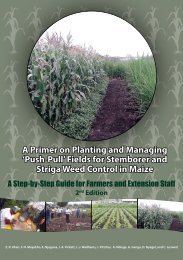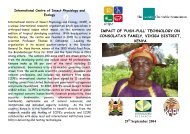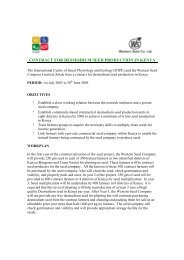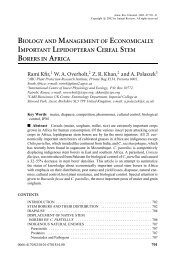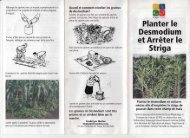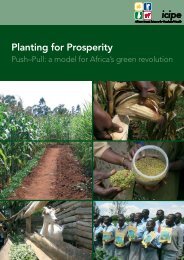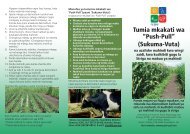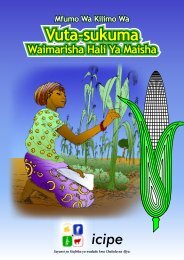The Royal Society Report - Push-Pull
The Royal Society Report - Push-Pull
The Royal Society Report - Push-Pull
You also want an ePaper? Increase the reach of your titles
YUMPU automatically turns print PDFs into web optimized ePapers that Google loves.
eing their livelihood, agriculture is for many people a key<br />
part of their society.<br />
In the period from 1965 to 1985, poverty reduction across<br />
the world advanced further than in the previous two<br />
centuries (Lipton 2001). Agriculture provides a potential<br />
route to poverty alleviation for many people around the<br />
world, but the diversity of social, economic and<br />
environmental contexts means that what works to<br />
improve crop outputs and system sustainability in some<br />
places may not work in others (World Bank 2008).<br />
To maintain such progress, agricultural systems in all parts<br />
of the world will have to make further improvements.<br />
Efforts to ensure access for poorer groups need to run<br />
alongside growth in aggregate food production. In many<br />
places, the challenge is to increase food production to<br />
solve immediate problems of hunger. In others, the focus<br />
will be more on adjustments which maintain food<br />
production whilst increasing the flow of environmental<br />
goods and services.<br />
Sub-Saharan Africa has seen fewer productivity gains than<br />
the rest of the world. Here there is significant potential for<br />
productivity increases, but there are also real challenges<br />
that need to be overcome. In the case of African<br />
smallholder farmers, changes that improve upon current<br />
agricultural systems rather than importing a radically<br />
different set of practices tend to be more effective (Reij &<br />
Smaling 2008; Sanchez et al. 2009a). Linking biological<br />
science with local practices requires a clear understanding<br />
of farmers’ own knowledge and innovations. <strong>The</strong>re are past<br />
examples where science has seemingly offered ‘solutions’<br />
to a problem but without success, because of a poor fit<br />
with local circumstances and a lack of local engagement<br />
with end-users at an early stage in the innovation process<br />
(Pretty 2002). In Burkina Faso, for example, researchers<br />
spent years developing systems of rainwater harvesting,<br />
but farmers did not adopt them. An NGO working closely<br />
with farmers has adapted simple soil and water<br />
conservation practices that have now led to significant<br />
improvements in food security and soil management<br />
(Hassame et al. 2000; Kaboré & Reij 2004). If agriculture<br />
continues to contribute to alleviating poverty, technologies<br />
for improving production need to be seen in their particular<br />
local social and economic contexts, as well as a broader<br />
context of public acceptance.<br />
Past debates about the use of new technologies in food<br />
production systems have tended to adopt an either/or<br />
approach, emphasising the merits of particular agricultural<br />
systems or technological approaches and the down-sides<br />
of others. This has been seen most obviously with respect<br />
to genetically modified (GM) crops, the use of pesticides<br />
and the arguments for and against organic modes of<br />
production. <strong>The</strong> reality is that there is no technological<br />
panacea for the global challenge of sustainable and secure<br />
food production. <strong>The</strong>re are always trade-offs and local<br />
complications. This report recognises that new crop<br />
varieties and appropriate agroecological practices are both<br />
needed to make the most of opportunities on all types of<br />
farms. We thus adopt an inclusive, both/and approach:<br />
no techniques or technologies should be ruled out before<br />
risks and benefits are assessed. Global agriculture<br />
demands a diversity of approaches that are specific<br />
to crops, localities, cultures and other circumstances.<br />
Such diversity demands that the breadth of relevant<br />
scientific enquiry is equally diverse, and that science<br />
needs to be combined with social, economic and political<br />
perspectives.<br />
1.7 Other major studies<br />
Our report follows a number of other reports and policy<br />
documents which have sought to describe and quantify<br />
the scale of the challenge of food security and food<br />
production from a variety of perspectives. Taken<br />
together, they provide a sense of likely future trends. <strong>The</strong><br />
differences in analysis, emphasis and recommendations<br />
show the range of options available for tackling the<br />
general issue.<br />
<strong>The</strong> most comprehensive recent analyses have been the<br />
World Bank’s 2008 World Development <strong>Report</strong> and the<br />
International Assessment of Agricultural Knowledge,<br />
Science and Technology for Development, also published<br />
in 2008 1 (IAASTD 2008; World Bank 2008).<br />
<strong>The</strong> 2008 World Development <strong>Report</strong> concluded that<br />
research and development are vital for global agriculture,<br />
and investment in R&D yields a high rate of return<br />
(43% per annum), yet it remains underfunded. <strong>The</strong><br />
report describes significant gains from crop genetic<br />
improvement but it also identifies places, particularly<br />
Sub-Saharan Africa, where improved crop varieties<br />
have yet to make such an impact. <strong>The</strong> challenge of a<br />
growing population is compounded by new threats,<br />
such as pests, diseases and climate change, and this<br />
further indicates the need for constant research into new<br />
varieties and practices (‘running to stand still’). Continued<br />
genetic improvement will be vital, but natural capital<br />
inputs to agriculture—including better soil and water<br />
management—will require new approaches too (World<br />
Bank 2008). <strong>The</strong> biggest gains from technology, the report<br />
concludes, come from combinations of improved crops<br />
and improved practices (the ‘both/and’ approach referred<br />
to above).<br />
<strong>The</strong> IAASTD was sponsored by the Food and Agricultural<br />
Organisation (FAO), Global Environment Facility (GEF),<br />
United Nations Development Programme (UNDP), United<br />
Nations Environment Programme (UNEP), United Nations<br />
Educational Scientific and Cultural Organisation (UNESCO),<br />
the World Bank and World Health Organisation (WHO),<br />
and its 4-year process was overseen by stakeholders from<br />
1 Many recent reviews point back to a single report: Rosegrant MW,<br />
Msangi S, Sulser T & Ringler C (2008). Future scenarios for agriculture.<br />
Plausible futures to 2030 and key trends in agricultural growth.<br />
International Food Policy Research Institute. This was a Working Paper<br />
submitted for consideration in the 2008 World Development <strong>Report</strong>.<br />
<strong>The</strong> data from this paper appears to have been rewritten as a<br />
background paper for the WDR but not re-published.<br />
8 I October 2009 I Reaping the Benefits <strong>The</strong> <strong>Royal</strong> <strong>Society</strong>



